Management Accounting Systems and Techniques for Aridri Company
VerifiedAdded on 2020/12/09
|17
|4666
|346
Report
AI Summary
This report provides a comprehensive overview of management accounting systems and techniques, focusing on their application within the context of a manufacturing company, Aridri. The report begins with an introduction to management accounting, its types, and its significance for business planning and control, particularly for small organizations. It then delves into specific methods, including price optimization, job costing, cost accounting, and inventory management systems, highlighting their benefits. The report further examines management accounting reporting, covering budgeting, job cost, and inventory reports, alongside their integration within organizational processes. A key section of the report focuses on cost calculations, preparing income statements using both marginal and absorption costing methods, and includes a break-even analysis. The report also analyzes different planning tools for budgetary control, evaluating their advantages and disadvantages, and explores how organizations adapt management accounting systems to resolve financial problems, culminating in an evaluation of how planning tools respond to solve financial problems.

Management Accounting
Systems & Techniques
Systems & Techniques
Paraphrase This Document
Need a fresh take? Get an instant paraphrase of this document with our AI Paraphraser
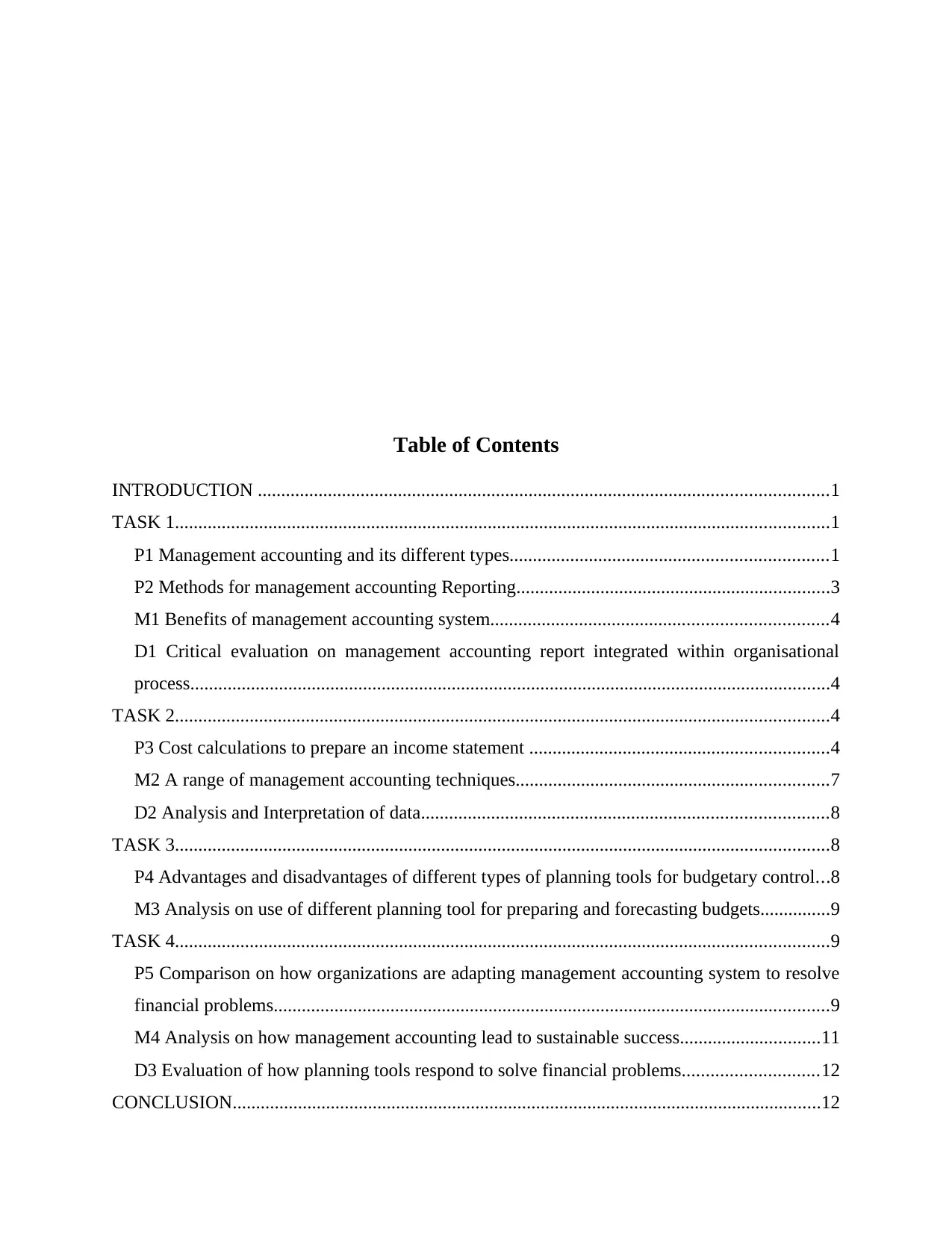
Table of Contents
INTRODUCTION ..........................................................................................................................1
TASK 1............................................................................................................................................1
P1 Management accounting and its different types....................................................................1
P2 Methods for management accounting Reporting...................................................................3
M1 Benefits of management accounting system........................................................................4
D1 Critical evaluation on management accounting report integrated within organisational
process.........................................................................................................................................4
TASK 2............................................................................................................................................4
P3 Cost calculations to prepare an income statement ................................................................4
M2 A range of management accounting techniques...................................................................7
D2 Analysis and Interpretation of data.......................................................................................8
TASK 3............................................................................................................................................8
P4 Advantages and disadvantages of different types of planning tools for budgetary control...8
M3 Analysis on use of different planning tool for preparing and forecasting budgets...............9
TASK 4............................................................................................................................................9
P5 Comparison on how organizations are adapting management accounting system to resolve
financial problems.......................................................................................................................9
M4 Analysis on how management accounting lead to sustainable success..............................11
D3 Evaluation of how planning tools respond to solve financial problems.............................12
CONCLUSION..............................................................................................................................12
INTRODUCTION ..........................................................................................................................1
TASK 1............................................................................................................................................1
P1 Management accounting and its different types....................................................................1
P2 Methods for management accounting Reporting...................................................................3
M1 Benefits of management accounting system........................................................................4
D1 Critical evaluation on management accounting report integrated within organisational
process.........................................................................................................................................4
TASK 2............................................................................................................................................4
P3 Cost calculations to prepare an income statement ................................................................4
M2 A range of management accounting techniques...................................................................7
D2 Analysis and Interpretation of data.......................................................................................8
TASK 3............................................................................................................................................8
P4 Advantages and disadvantages of different types of planning tools for budgetary control...8
M3 Analysis on use of different planning tool for preparing and forecasting budgets...............9
TASK 4............................................................................................................................................9
P5 Comparison on how organizations are adapting management accounting system to resolve
financial problems.......................................................................................................................9
M4 Analysis on how management accounting lead to sustainable success..............................11
D3 Evaluation of how planning tools respond to solve financial problems.............................12
CONCLUSION..............................................................................................................................12
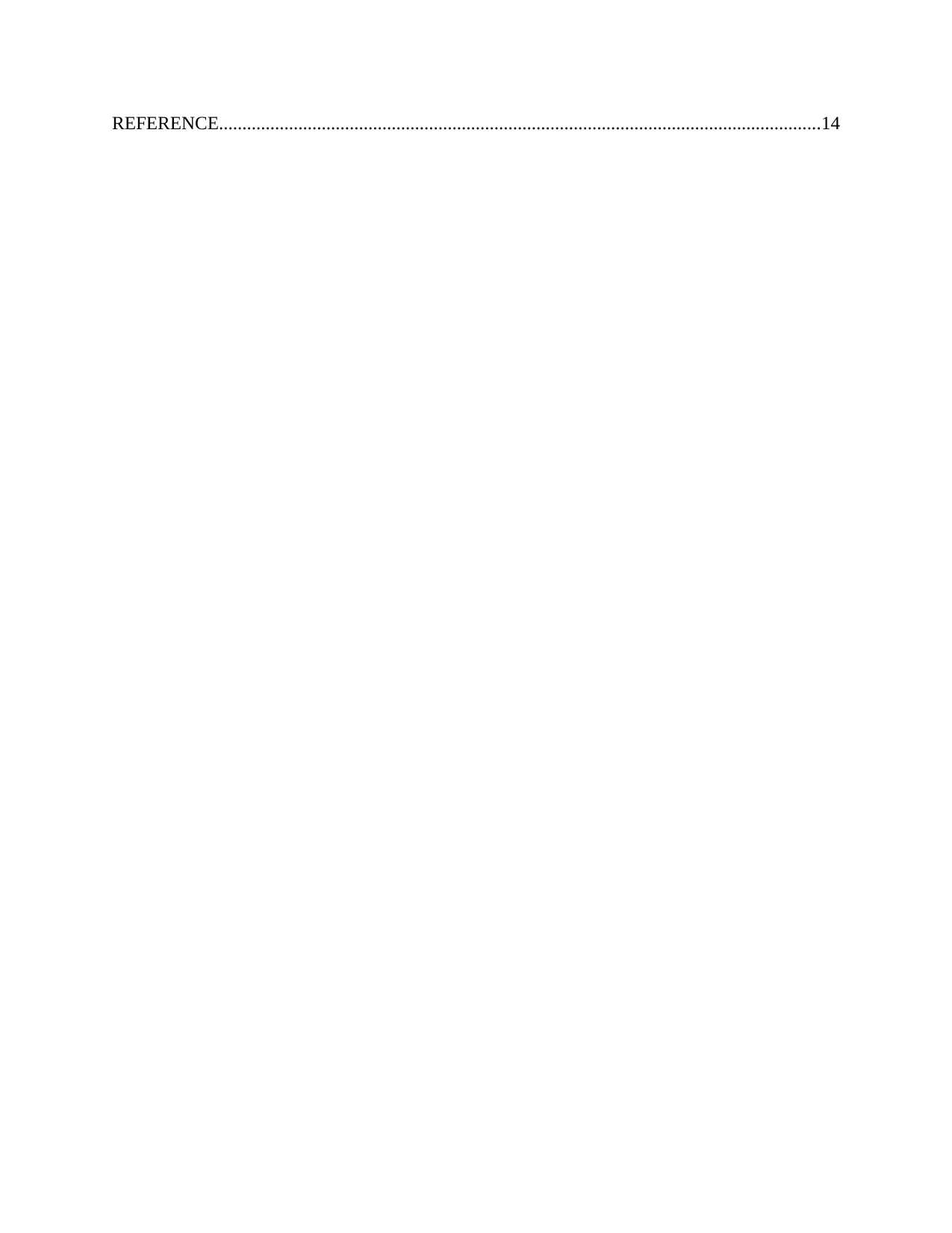
REFERENCE.................................................................................................................................14
⊘ This is a preview!⊘
Do you want full access?
Subscribe today to unlock all pages.

Trusted by 1+ million students worldwide
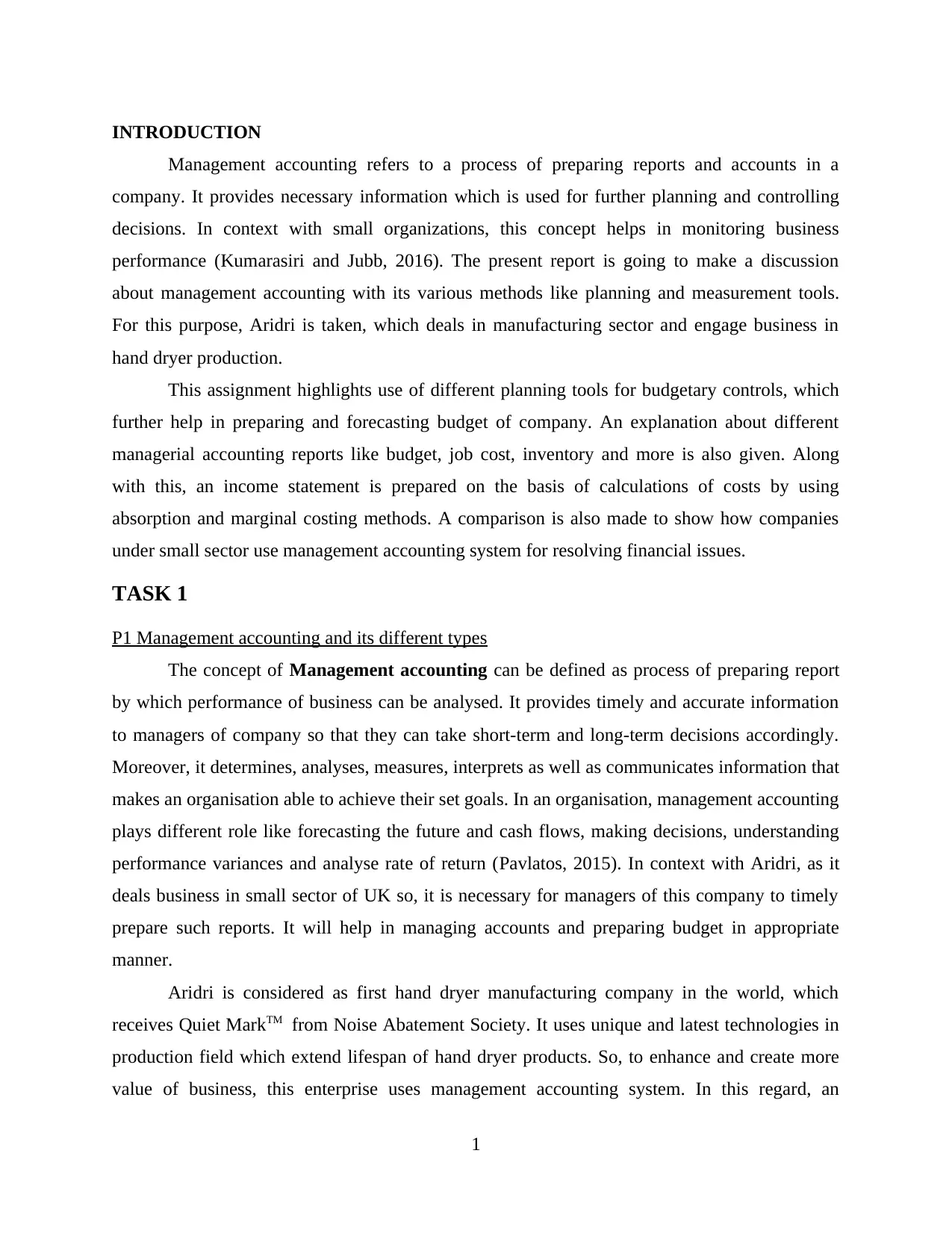
INTRODUCTION
Management accounting refers to a process of preparing reports and accounts in a
company. It provides necessary information which is used for further planning and controlling
decisions. In context with small organizations, this concept helps in monitoring business
performance (Kumarasiri and Jubb, 2016). The present report is going to make a discussion
about management accounting with its various methods like planning and measurement tools.
For this purpose, Aridri is taken, which deals in manufacturing sector and engage business in
hand dryer production.
This assignment highlights use of different planning tools for budgetary controls, which
further help in preparing and forecasting budget of company. An explanation about different
managerial accounting reports like budget, job cost, inventory and more is also given. Along
with this, an income statement is prepared on the basis of calculations of costs by using
absorption and marginal costing methods. A comparison is also made to show how companies
under small sector use management accounting system for resolving financial issues.
TASK 1
P1 Management accounting and its different types
The concept of Management accounting can be defined as process of preparing report
by which performance of business can be analysed. It provides timely and accurate information
to managers of company so that they can take short-term and long-term decisions accordingly.
Moreover, it determines, analyses, measures, interprets as well as communicates information that
makes an organisation able to achieve their set goals. In an organisation, management accounting
plays different role like forecasting the future and cash flows, making decisions, understanding
performance variances and analyse rate of return (Pavlatos, 2015). In context with Aridri, as it
deals business in small sector of UK so, it is necessary for managers of this company to timely
prepare such reports. It will help in managing accounts and preparing budget in appropriate
manner.
Aridri is considered as first hand dryer manufacturing company in the world, which
receives Quiet MarkTM from Noise Abatement Society. It uses unique and latest technologies in
production field which extend lifespan of hand dryer products. So, to enhance and create more
value of business, this enterprise uses management accounting system. In this regard, an
1
Management accounting refers to a process of preparing reports and accounts in a
company. It provides necessary information which is used for further planning and controlling
decisions. In context with small organizations, this concept helps in monitoring business
performance (Kumarasiri and Jubb, 2016). The present report is going to make a discussion
about management accounting with its various methods like planning and measurement tools.
For this purpose, Aridri is taken, which deals in manufacturing sector and engage business in
hand dryer production.
This assignment highlights use of different planning tools for budgetary controls, which
further help in preparing and forecasting budget of company. An explanation about different
managerial accounting reports like budget, job cost, inventory and more is also given. Along
with this, an income statement is prepared on the basis of calculations of costs by using
absorption and marginal costing methods. A comparison is also made to show how companies
under small sector use management accounting system for resolving financial issues.
TASK 1
P1 Management accounting and its different types
The concept of Management accounting can be defined as process of preparing report
by which performance of business can be analysed. It provides timely and accurate information
to managers of company so that they can take short-term and long-term decisions accordingly.
Moreover, it determines, analyses, measures, interprets as well as communicates information that
makes an organisation able to achieve their set goals. In an organisation, management accounting
plays different role like forecasting the future and cash flows, making decisions, understanding
performance variances and analyse rate of return (Pavlatos, 2015). In context with Aridri, as it
deals business in small sector of UK so, it is necessary for managers of this company to timely
prepare such reports. It will help in managing accounts and preparing budget in appropriate
manner.
Aridri is considered as first hand dryer manufacturing company in the world, which
receives Quiet MarkTM from Noise Abatement Society. It uses unique and latest technologies in
production field which extend lifespan of hand dryer products. So, to enhance and create more
value of business, this enterprise uses management accounting system. In this regard, an
1
Paraphrase This Document
Need a fresh take? Get an instant paraphrase of this document with our AI Paraphraser
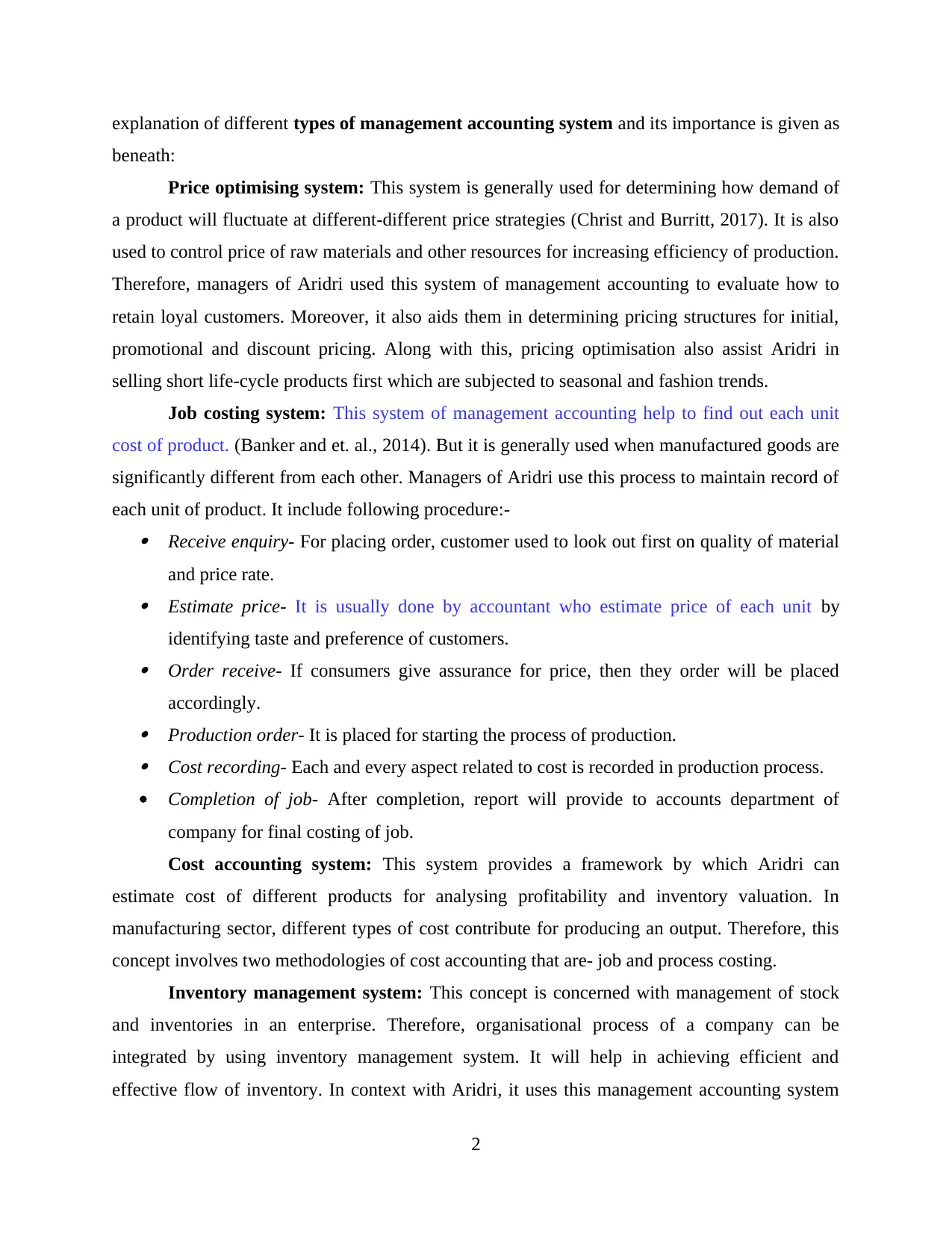
explanation of different types of management accounting system and its importance is given as
beneath:
Price optimising system: This system is generally used for determining how demand of
a product will fluctuate at different-different price strategies (Christ and Burritt, 2017). It is also
used to control price of raw materials and other resources for increasing efficiency of production.
Therefore, managers of Aridri used this system of management accounting to evaluate how to
retain loyal customers. Moreover, it also aids them in determining pricing structures for initial,
promotional and discount pricing. Along with this, pricing optimisation also assist Aridri in
selling short life-cycle products first which are subjected to seasonal and fashion trends.
Job costing system: This system of management accounting help to find out each unit
cost of product. (Banker and et. al., 2014). But it is generally used when manufactured goods are
significantly different from each other. Managers of Aridri use this process to maintain record of
each unit of product. It include following procedure:- Receive enquiry- For placing order, customer used to look out first on quality of material
and price rate. Estimate price- It is usually done by accountant who estimate price of each unit by
identifying taste and preference of customers. Order receive- If consumers give assurance for price, then they order will be placed
accordingly. Production order- It is placed for starting the process of production. Cost recording- Each and every aspect related to cost is recorded in production process.
Completion of job- After completion, report will provide to accounts department of
company for final costing of job.
Cost accounting system: This system provides a framework by which Aridri can
estimate cost of different products for analysing profitability and inventory valuation. In
manufacturing sector, different types of cost contribute for producing an output. Therefore, this
concept involves two methodologies of cost accounting that are- job and process costing.
Inventory management system: This concept is concerned with management of stock
and inventories in an enterprise. Therefore, organisational process of a company can be
integrated by using inventory management system. It will help in achieving efficient and
effective flow of inventory. In context with Aridri, it uses this management accounting system
2
beneath:
Price optimising system: This system is generally used for determining how demand of
a product will fluctuate at different-different price strategies (Christ and Burritt, 2017). It is also
used to control price of raw materials and other resources for increasing efficiency of production.
Therefore, managers of Aridri used this system of management accounting to evaluate how to
retain loyal customers. Moreover, it also aids them in determining pricing structures for initial,
promotional and discount pricing. Along with this, pricing optimisation also assist Aridri in
selling short life-cycle products first which are subjected to seasonal and fashion trends.
Job costing system: This system of management accounting help to find out each unit
cost of product. (Banker and et. al., 2014). But it is generally used when manufactured goods are
significantly different from each other. Managers of Aridri use this process to maintain record of
each unit of product. It include following procedure:- Receive enquiry- For placing order, customer used to look out first on quality of material
and price rate. Estimate price- It is usually done by accountant who estimate price of each unit by
identifying taste and preference of customers. Order receive- If consumers give assurance for price, then they order will be placed
accordingly. Production order- It is placed for starting the process of production. Cost recording- Each and every aspect related to cost is recorded in production process.
Completion of job- After completion, report will provide to accounts department of
company for final costing of job.
Cost accounting system: This system provides a framework by which Aridri can
estimate cost of different products for analysing profitability and inventory valuation. In
manufacturing sector, different types of cost contribute for producing an output. Therefore, this
concept involves two methodologies of cost accounting that are- job and process costing.
Inventory management system: This concept is concerned with management of stock
and inventories in an enterprise. Therefore, organisational process of a company can be
integrated by using inventory management system. It will help in achieving efficient and
effective flow of inventory. In context with Aridri, it uses this management accounting system
2

with aim to generate high return profitability by minimising the total cost of inventories. This
accounting system includes many methods like LIFO (Last in first out), FIFO (First-In First-Out)
and prioritise with ABC. Managers of Aridri use ABC analysis in order to focus on those
products which provide more profit for business. In this era, products of A category required
more and regular attention because impact of them is financially significant. Similarly, B and C
category include moderate and low-value products respectively which have a high frequency of
sales.
P2 Methods for management accounting Reporting
Accounting reports are most crucial part in business which helps in determining how
company is performing. This concept assists small organizations to monitor the performance of
business (Jack, 2015). In this regard, managers of a firm can prepare different reports either in
quarterly, weekly or monthly basis. It provide accurate and reliable statistical information so
management can take decision according to it. In context with Aridri, different types of
management accounting reports and their benefits for business are discussed in following
manner:-
Budgeting report: This report sets out the plan for analysing performance of different
departments and control costs. Estimated budget of a company is usually based on actual
expenses. So, managers of Aridri design this report to analyse and compare how close budgeted
performance of business during a financial period was to the actual one.
Job cost reports: It is concerned with determining expenses, costs and profitability of
each job in manufacturing process. This report provides crucial information to a company about
its current status of a particular job. As Aridri deals in manufacturing field and use a wide range
of raw materials for producing high quality of hand dryer products. So, using job cost report, it
can control addition expenses so that efficiency of production can be increased.
Inventory and manufacturing report: This kind of management accounting report is
generally used by manufacturing and construction companies (Smith, Brännström and Jansson,
2015). It includes information about labour cost, wastages and each unit overhead costs.
Therefore, employers of Aridri prepare this report to see opportunities by which they can make
improvement in manufacturing process.
3
accounting system includes many methods like LIFO (Last in first out), FIFO (First-In First-Out)
and prioritise with ABC. Managers of Aridri use ABC analysis in order to focus on those
products which provide more profit for business. In this era, products of A category required
more and regular attention because impact of them is financially significant. Similarly, B and C
category include moderate and low-value products respectively which have a high frequency of
sales.
P2 Methods for management accounting Reporting
Accounting reports are most crucial part in business which helps in determining how
company is performing. This concept assists small organizations to monitor the performance of
business (Jack, 2015). In this regard, managers of a firm can prepare different reports either in
quarterly, weekly or monthly basis. It provide accurate and reliable statistical information so
management can take decision according to it. In context with Aridri, different types of
management accounting reports and their benefits for business are discussed in following
manner:-
Budgeting report: This report sets out the plan for analysing performance of different
departments and control costs. Estimated budget of a company is usually based on actual
expenses. So, managers of Aridri design this report to analyse and compare how close budgeted
performance of business during a financial period was to the actual one.
Job cost reports: It is concerned with determining expenses, costs and profitability of
each job in manufacturing process. This report provides crucial information to a company about
its current status of a particular job. As Aridri deals in manufacturing field and use a wide range
of raw materials for producing high quality of hand dryer products. So, using job cost report, it
can control addition expenses so that efficiency of production can be increased.
Inventory and manufacturing report: This kind of management accounting report is
generally used by manufacturing and construction companies (Smith, Brännström and Jansson,
2015). It includes information about labour cost, wastages and each unit overhead costs.
Therefore, employers of Aridri prepare this report to see opportunities by which they can make
improvement in manufacturing process.
3
⊘ This is a preview!⊘
Do you want full access?
Subscribe today to unlock all pages.

Trusted by 1+ million students worldwide

M1 Benefits of management accounting system
System Benefits
Price Optimisation System Since price is considered as the most adjustable element in
marketing mix (Joshi and Li, 2016). So, using this method
of management accounting, Aridri can outline behaviour of
customers with different level of pricing.
Job Costing System Integrated this system in business, managers of Aridri can
access the expenses incurred on specific job. Through this
process, they can develop strategies for controlling cost in
better manner in future.
Cost Accounting System This concept allow managers of Aridri to fix price of each
products on the basis of production cost.
Inventory Management System Using this system, Aridri can achieve productivity and
efficiency in production by maintaining stock of
inventories.
D1 Critical evaluation on management accounting report integrated within organisational process
Types of reporting Integrated within organisational process
Budgeting Report By preparing this report, managers of Aridri can create a
path by which set goals and objectives can be
accomplished in given span of time.
Job Cost Report This report helps in reducing and minimising overall cost
of production.
Inventory and manufacturing
report
Integrating this report within organisational process aids
Aridri in improving the accuracy of inventory orders.
4
System Benefits
Price Optimisation System Since price is considered as the most adjustable element in
marketing mix (Joshi and Li, 2016). So, using this method
of management accounting, Aridri can outline behaviour of
customers with different level of pricing.
Job Costing System Integrated this system in business, managers of Aridri can
access the expenses incurred on specific job. Through this
process, they can develop strategies for controlling cost in
better manner in future.
Cost Accounting System This concept allow managers of Aridri to fix price of each
products on the basis of production cost.
Inventory Management System Using this system, Aridri can achieve productivity and
efficiency in production by maintaining stock of
inventories.
D1 Critical evaluation on management accounting report integrated within organisational process
Types of reporting Integrated within organisational process
Budgeting Report By preparing this report, managers of Aridri can create a
path by which set goals and objectives can be
accomplished in given span of time.
Job Cost Report This report helps in reducing and minimising overall cost
of production.
Inventory and manufacturing
report
Integrating this report within organisational process aids
Aridri in improving the accuracy of inventory orders.
4
Paraphrase This Document
Need a fresh take? Get an instant paraphrase of this document with our AI Paraphraser

TASK 2
P3 Cost calculations to prepare an income statement
Cost refers to an amount which has to be paid to get something. In context with business,
this term usually defines monetary valuation of materials, efforts, risk incurred, time consumed
and delivery of a product or service at marketplace (Ji, 2017). In general, cost majorly classified
in two forms- Fixed and Variable. A fixed cost is a type of expense which does not change with
increase in volume of production. It is defined as predetermined rates that are based on
necessities of company. It includes insurance, property taxes and rent of building. While the
amount which varies with production or change in total output, termed as variable cost. Direct
labour cost related to different level of output, sales commission and more, are some examples of
variable costs.
Marginal Costing: This concept of costing is based on variation of cost which changes
with volume of output. It is also known as 'variable costing' under which variable cost is
accumulated only. While fixed cost is completely written off for the period against contribution.
Moreover, in marginal costing, cost per unit remains constant also (Schaltegger, Burritt and
Petersen, 2017).
Absorption Costing: In this costing, on the basis of predetermined level of output, fixed
expenses are generally distributed over products. Absorption costing can be defined as
managerial accounting cost method where entire manufacturing costs are absorbed. Under this
costing, expenses are classified on the basis of function. As comparison with marginal,
absorption costing consider both variable and fixed cost for inventory valuation.
Working Notes:
Income statement as per marginal costing:
Net income = (sales revenue – marginal cost of goods sold) = (contribution – fixed cost)
Particulars Amount
Sales revenue = (no. of units sold x selling price of each = 600 x 55) £33000
Marginal Cost of products sold: £9600
Production = (units produced x marginal cost per unit = 800 x 16) 12800
5
P3 Cost calculations to prepare an income statement
Cost refers to an amount which has to be paid to get something. In context with business,
this term usually defines monetary valuation of materials, efforts, risk incurred, time consumed
and delivery of a product or service at marketplace (Ji, 2017). In general, cost majorly classified
in two forms- Fixed and Variable. A fixed cost is a type of expense which does not change with
increase in volume of production. It is defined as predetermined rates that are based on
necessities of company. It includes insurance, property taxes and rent of building. While the
amount which varies with production or change in total output, termed as variable cost. Direct
labour cost related to different level of output, sales commission and more, are some examples of
variable costs.
Marginal Costing: This concept of costing is based on variation of cost which changes
with volume of output. It is also known as 'variable costing' under which variable cost is
accumulated only. While fixed cost is completely written off for the period against contribution.
Moreover, in marginal costing, cost per unit remains constant also (Schaltegger, Burritt and
Petersen, 2017).
Absorption Costing: In this costing, on the basis of predetermined level of output, fixed
expenses are generally distributed over products. Absorption costing can be defined as
managerial accounting cost method where entire manufacturing costs are absorbed. Under this
costing, expenses are classified on the basis of function. As comparison with marginal,
absorption costing consider both variable and fixed cost for inventory valuation.
Working Notes:
Income statement as per marginal costing:
Net income = (sales revenue – marginal cost of goods sold) = (contribution – fixed cost)
Particulars Amount
Sales revenue = (no. of units sold x selling price of each = 600 x 55) £33000
Marginal Cost of products sold: £9600
Production = (units produced x marginal cost per unit = 800 x 16) 12800
5
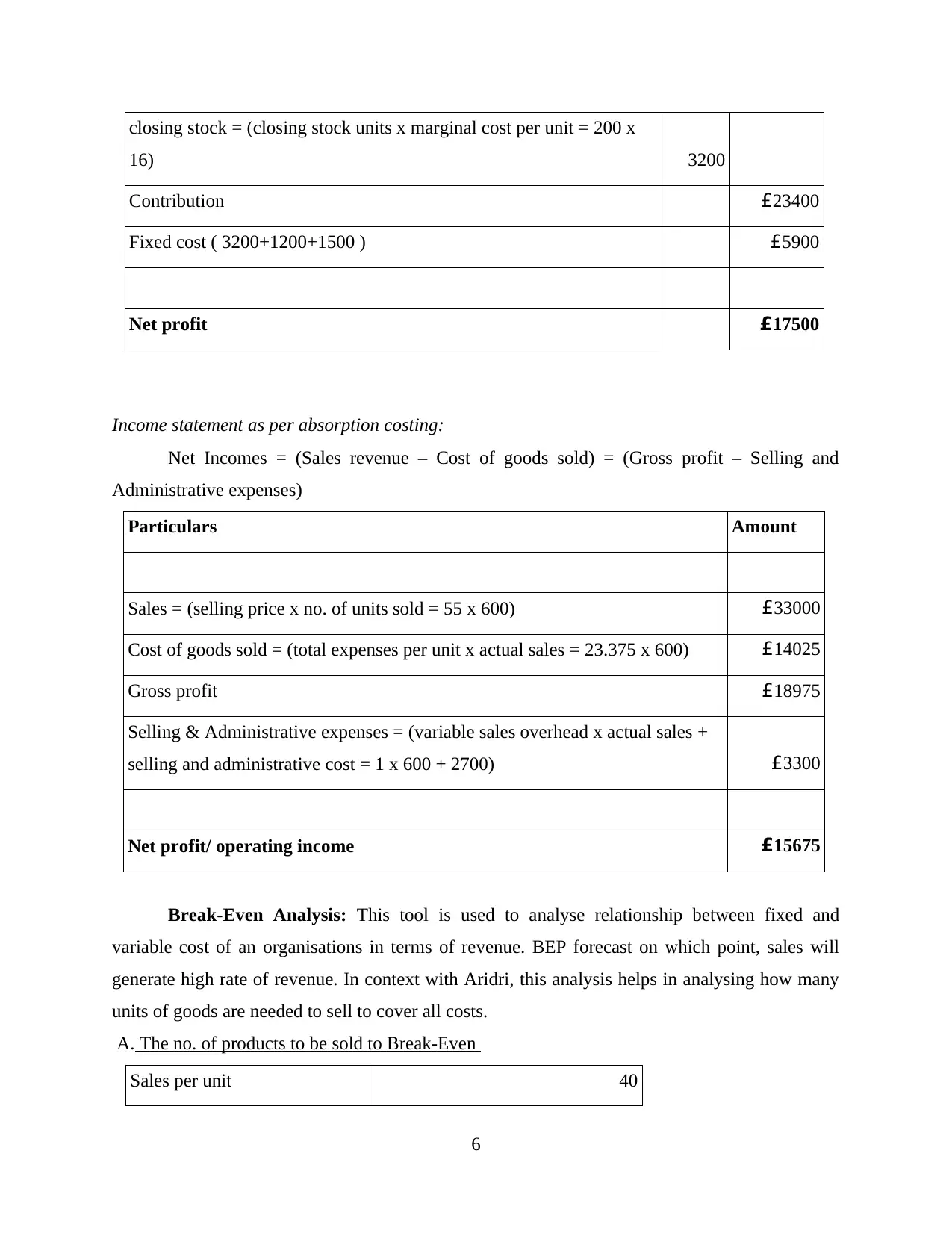
closing stock = (closing stock units x marginal cost per unit = 200 x
16) 3200
Contribution £23400
Fixed cost ( 3200+1200+1500 ) £5900
Net profit £17500
Income statement as per absorption costing:
Net Incomes = (Sales revenue – Cost of goods sold) = (Gross profit – Selling and
Administrative expenses)
Particulars Amount
Sales = (selling price x no. of units sold = 55 x 600) £33000
Cost of goods sold = (total expenses per unit x actual sales = 23.375 x 600) £14025
Gross profit £18975
Selling & Administrative expenses = (variable sales overhead x actual sales +
selling and administrative cost = 1 x 600 + 2700) £3300
Net profit/ operating income £15675
Break-Even Analysis: This tool is used to analyse relationship between fixed and
variable cost of an organisations in terms of revenue. BEP forecast on which point, sales will
generate high rate of revenue. In context with Aridri, this analysis helps in analysing how many
units of goods are needed to sell to cover all costs.
A. The no. of products to be sold to Break-Even
Sales per unit 40
6
16) 3200
Contribution £23400
Fixed cost ( 3200+1200+1500 ) £5900
Net profit £17500
Income statement as per absorption costing:
Net Incomes = (Sales revenue – Cost of goods sold) = (Gross profit – Selling and
Administrative expenses)
Particulars Amount
Sales = (selling price x no. of units sold = 55 x 600) £33000
Cost of goods sold = (total expenses per unit x actual sales = 23.375 x 600) £14025
Gross profit £18975
Selling & Administrative expenses = (variable sales overhead x actual sales +
selling and administrative cost = 1 x 600 + 2700) £3300
Net profit/ operating income £15675
Break-Even Analysis: This tool is used to analyse relationship between fixed and
variable cost of an organisations in terms of revenue. BEP forecast on which point, sales will
generate high rate of revenue. In context with Aridri, this analysis helps in analysing how many
units of goods are needed to sell to cover all costs.
A. The no. of products to be sold to Break-Even
Sales per unit 40
6
⊘ This is a preview!⊘
Do you want full access?
Subscribe today to unlock all pages.

Trusted by 1+ million students worldwide

Variable costs VC = DM +
DL 28
Contribution 12
Fixed costs 6000
BEP in units 500
B. Break-even point in terms of sales revenue
Sales per unit 40
Variable costs VC = DM + DL 28
Contribution 12
Fixed costs 6000
Profit volume ratio PVR = Contribution /
sales * 100 30.00%
BEP in sales 20000
C. Number of products to make sold to generate desired profitability of £10,000
Profit 10000
Fixed costs 6000
Contribution 16000
Contribution per unit 12
Sales 1333.33
D. Margin of Safety when 800 products are sold
Formula for MOS
Margin of Safety = Budgeted or actual sales – Sales required to Break-Even
Actual sales in units 800
Break even sales in units 500
7
DL 28
Contribution 12
Fixed costs 6000
BEP in units 500
B. Break-even point in terms of sales revenue
Sales per unit 40
Variable costs VC = DM + DL 28
Contribution 12
Fixed costs 6000
Profit volume ratio PVR = Contribution /
sales * 100 30.00%
BEP in sales 20000
C. Number of products to make sold to generate desired profitability of £10,000
Profit 10000
Fixed costs 6000
Contribution 16000
Contribution per unit 12
Sales 1333.33
D. Margin of Safety when 800 products are sold
Formula for MOS
Margin of Safety = Budgeted or actual sales – Sales required to Break-Even
Actual sales in units 800
Break even sales in units 500
7
Paraphrase This Document
Need a fresh take? Get an instant paraphrase of this document with our AI Paraphraser
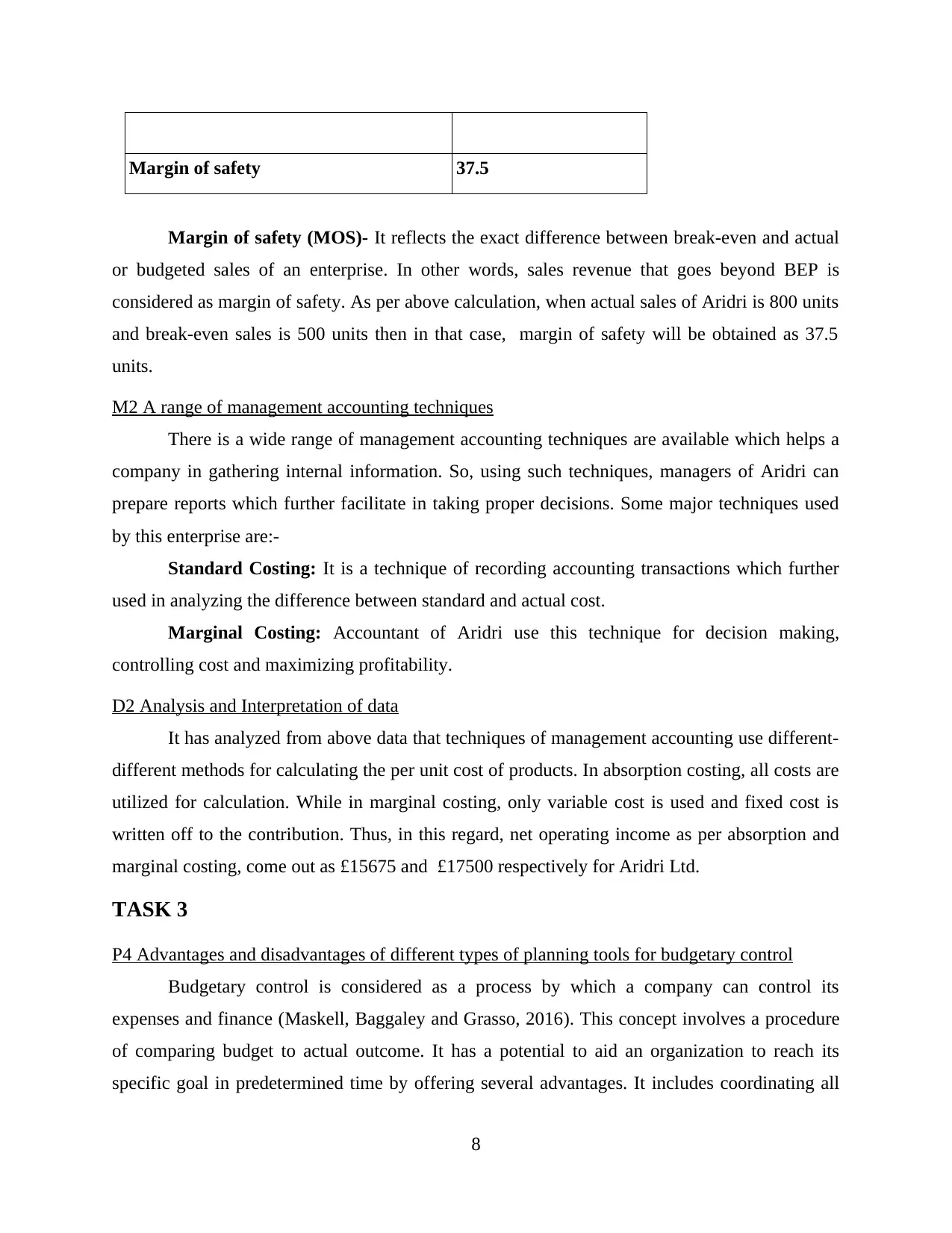
Margin of safety 37.5
Margin of safety (MOS)- It reflects the exact difference between break-even and actual
or budgeted sales of an enterprise. In other words, sales revenue that goes beyond BEP is
considered as margin of safety. As per above calculation, when actual sales of Aridri is 800 units
and break-even sales is 500 units then in that case, margin of safety will be obtained as 37.5
units.
M2 A range of management accounting techniques
There is a wide range of management accounting techniques are available which helps a
company in gathering internal information. So, using such techniques, managers of Aridri can
prepare reports which further facilitate in taking proper decisions. Some major techniques used
by this enterprise are:-
Standard Costing: It is a technique of recording accounting transactions which further
used in analyzing the difference between standard and actual cost.
Marginal Costing: Accountant of Aridri use this technique for decision making,
controlling cost and maximizing profitability.
D2 Analysis and Interpretation of data
It has analyzed from above data that techniques of management accounting use different-
different methods for calculating the per unit cost of products. In absorption costing, all costs are
utilized for calculation. While in marginal costing, only variable cost is used and fixed cost is
written off to the contribution. Thus, in this regard, net operating income as per absorption and
marginal costing, come out as £15675 and £17500 respectively for Aridri Ltd.
TASK 3
P4 Advantages and disadvantages of different types of planning tools for budgetary control
Budgetary control is considered as a process by which a company can control its
expenses and finance (Maskell, Baggaley and Grasso, 2016). This concept involves a procedure
of comparing budget to actual outcome. It has a potential to aid an organization to reach its
specific goal in predetermined time by offering several advantages. It includes coordinating all
8
Margin of safety (MOS)- It reflects the exact difference between break-even and actual
or budgeted sales of an enterprise. In other words, sales revenue that goes beyond BEP is
considered as margin of safety. As per above calculation, when actual sales of Aridri is 800 units
and break-even sales is 500 units then in that case, margin of safety will be obtained as 37.5
units.
M2 A range of management accounting techniques
There is a wide range of management accounting techniques are available which helps a
company in gathering internal information. So, using such techniques, managers of Aridri can
prepare reports which further facilitate in taking proper decisions. Some major techniques used
by this enterprise are:-
Standard Costing: It is a technique of recording accounting transactions which further
used in analyzing the difference between standard and actual cost.
Marginal Costing: Accountant of Aridri use this technique for decision making,
controlling cost and maximizing profitability.
D2 Analysis and Interpretation of data
It has analyzed from above data that techniques of management accounting use different-
different methods for calculating the per unit cost of products. In absorption costing, all costs are
utilized for calculation. While in marginal costing, only variable cost is used and fixed cost is
written off to the contribution. Thus, in this regard, net operating income as per absorption and
marginal costing, come out as £15675 and £17500 respectively for Aridri Ltd.
TASK 3
P4 Advantages and disadvantages of different types of planning tools for budgetary control
Budgetary control is considered as a process by which a company can control its
expenses and finance (Maskell, Baggaley and Grasso, 2016). This concept involves a procedure
of comparing budget to actual outcome. It has a potential to aid an organization to reach its
specific goal in predetermined time by offering several advantages. It includes coordinating all
8
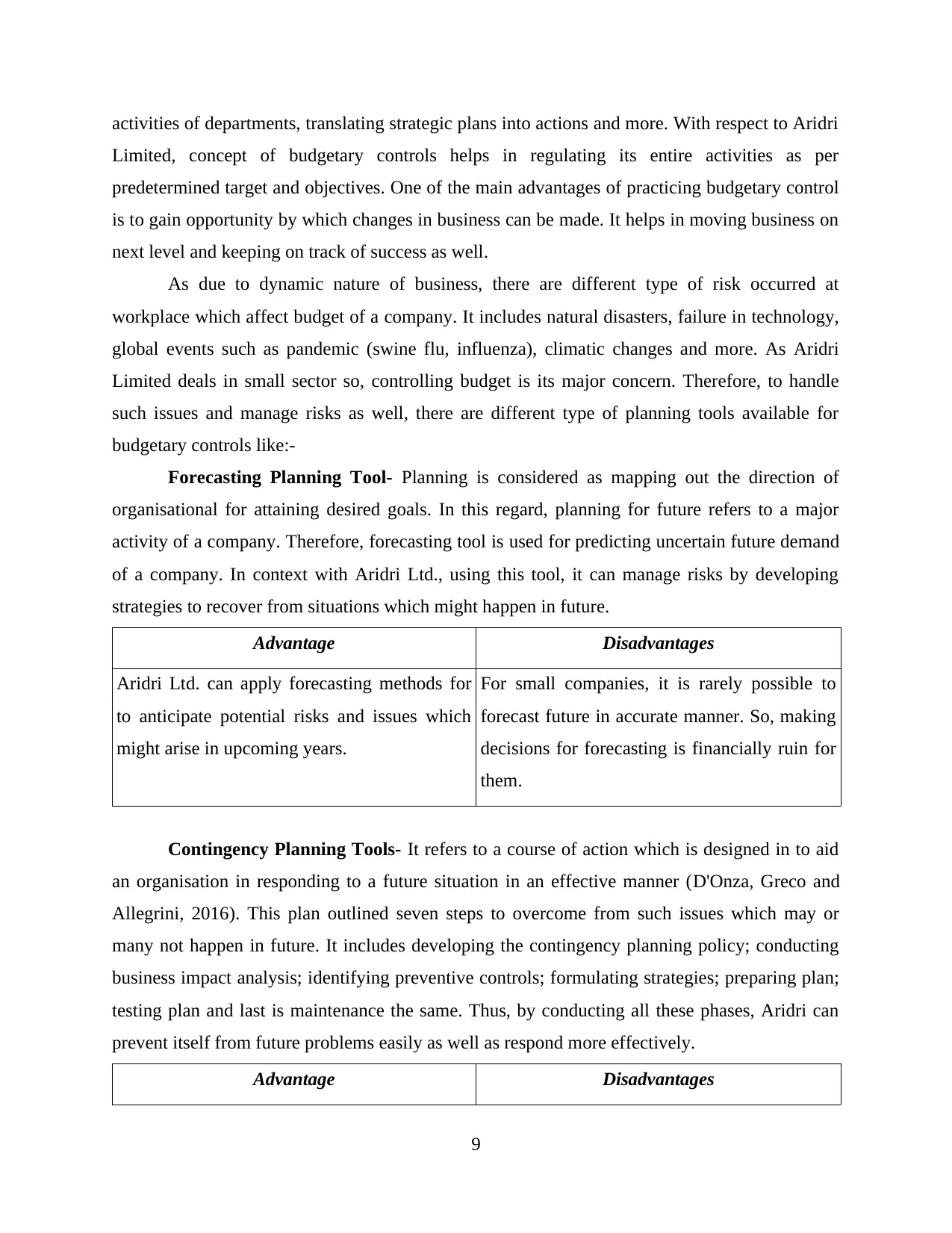
activities of departments, translating strategic plans into actions and more. With respect to Aridri
Limited, concept of budgetary controls helps in regulating its entire activities as per
predetermined target and objectives. One of the main advantages of practicing budgetary control
is to gain opportunity by which changes in business can be made. It helps in moving business on
next level and keeping on track of success as well.
As due to dynamic nature of business, there are different type of risk occurred at
workplace which affect budget of a company. It includes natural disasters, failure in technology,
global events such as pandemic (swine flu, influenza), climatic changes and more. As Aridri
Limited deals in small sector so, controlling budget is its major concern. Therefore, to handle
such issues and manage risks as well, there are different type of planning tools available for
budgetary controls like:-
Forecasting Planning Tool- Planning is considered as mapping out the direction of
organisational for attaining desired goals. In this regard, planning for future refers to a major
activity of a company. Therefore, forecasting tool is used for predicting uncertain future demand
of a company. In context with Aridri Ltd., using this tool, it can manage risks by developing
strategies to recover from situations which might happen in future.
Advantage Disadvantages
Aridri Ltd. can apply forecasting methods for
to anticipate potential risks and issues which
might arise in upcoming years.
For small companies, it is rarely possible to
forecast future in accurate manner. So, making
decisions for forecasting is financially ruin for
them.
Contingency Planning Tools- It refers to a course of action which is designed in to aid
an organisation in responding to a future situation in an effective manner (D'Onza, Greco and
Allegrini, 2016). This plan outlined seven steps to overcome from such issues which may or
many not happen in future. It includes developing the contingency planning policy; conducting
business impact analysis; identifying preventive controls; formulating strategies; preparing plan;
testing plan and last is maintenance the same. Thus, by conducting all these phases, Aridri can
prevent itself from future problems easily as well as respond more effectively.
Advantage Disadvantages
9
Limited, concept of budgetary controls helps in regulating its entire activities as per
predetermined target and objectives. One of the main advantages of practicing budgetary control
is to gain opportunity by which changes in business can be made. It helps in moving business on
next level and keeping on track of success as well.
As due to dynamic nature of business, there are different type of risk occurred at
workplace which affect budget of a company. It includes natural disasters, failure in technology,
global events such as pandemic (swine flu, influenza), climatic changes and more. As Aridri
Limited deals in small sector so, controlling budget is its major concern. Therefore, to handle
such issues and manage risks as well, there are different type of planning tools available for
budgetary controls like:-
Forecasting Planning Tool- Planning is considered as mapping out the direction of
organisational for attaining desired goals. In this regard, planning for future refers to a major
activity of a company. Therefore, forecasting tool is used for predicting uncertain future demand
of a company. In context with Aridri Ltd., using this tool, it can manage risks by developing
strategies to recover from situations which might happen in future.
Advantage Disadvantages
Aridri Ltd. can apply forecasting methods for
to anticipate potential risks and issues which
might arise in upcoming years.
For small companies, it is rarely possible to
forecast future in accurate manner. So, making
decisions for forecasting is financially ruin for
them.
Contingency Planning Tools- It refers to a course of action which is designed in to aid
an organisation in responding to a future situation in an effective manner (D'Onza, Greco and
Allegrini, 2016). This plan outlined seven steps to overcome from such issues which may or
many not happen in future. It includes developing the contingency planning policy; conducting
business impact analysis; identifying preventive controls; formulating strategies; preparing plan;
testing plan and last is maintenance the same. Thus, by conducting all these phases, Aridri can
prevent itself from future problems easily as well as respond more effectively.
Advantage Disadvantages
9
⊘ This is a preview!⊘
Do you want full access?
Subscribe today to unlock all pages.

Trusted by 1+ million students worldwide
1 out of 17
Related Documents
Your All-in-One AI-Powered Toolkit for Academic Success.
+13062052269
info@desklib.com
Available 24*7 on WhatsApp / Email
![[object Object]](/_next/static/media/star-bottom.7253800d.svg)
Unlock your academic potential
Copyright © 2020–2025 A2Z Services. All Rights Reserved. Developed and managed by ZUCOL.





